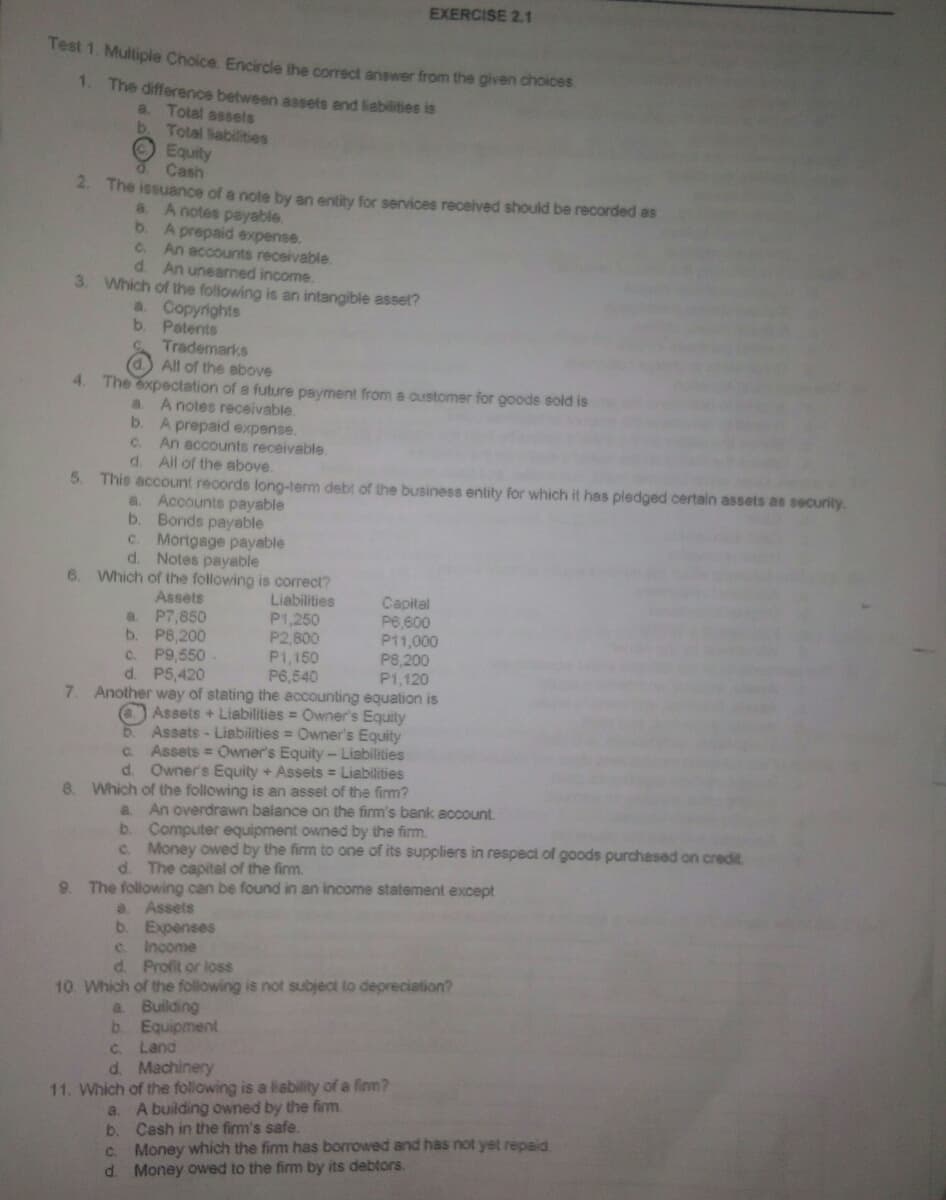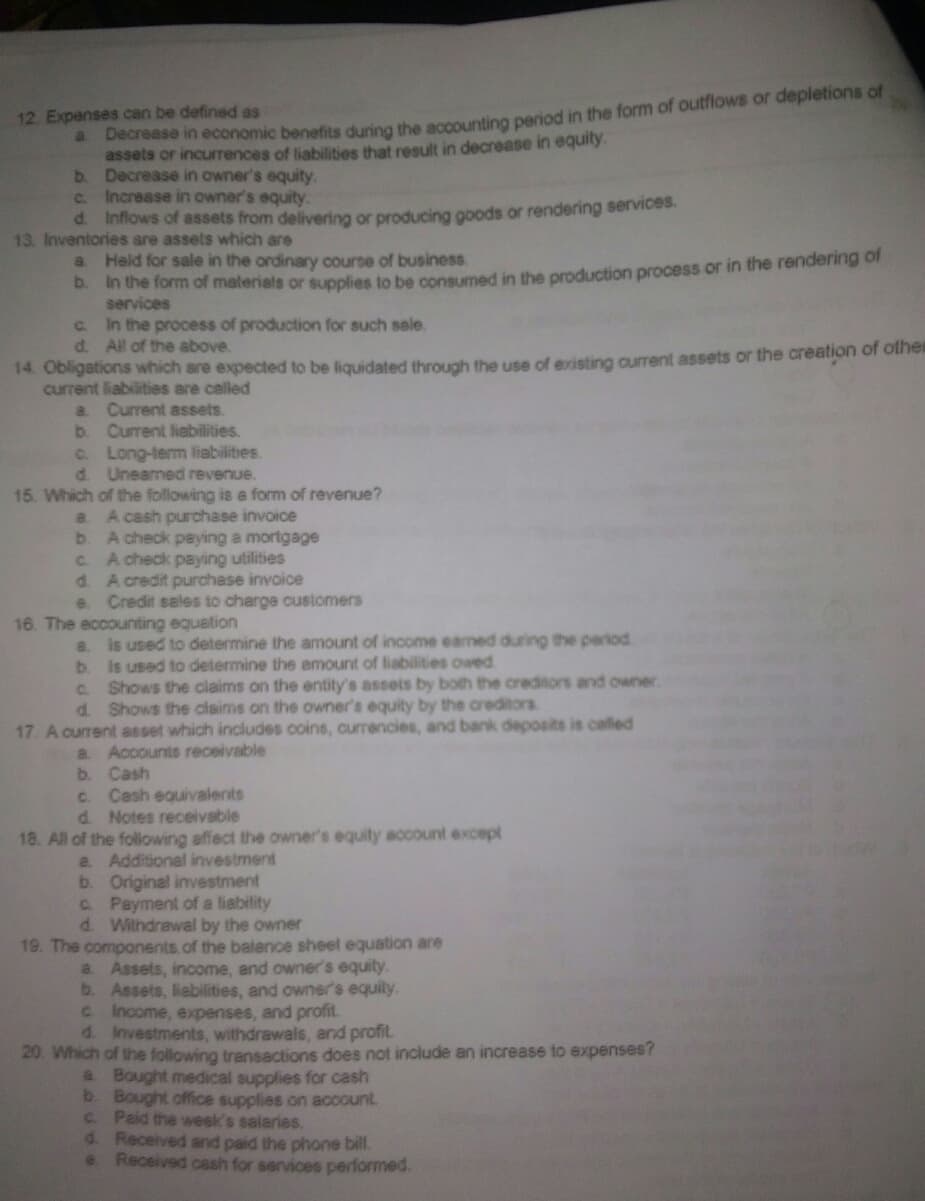Test 1. Multiple Choice. Encircle ihe correct answer from the given choices 1. The difference between assets and liabilities is a. Total sssels Total iabilities O Equity Cash 2. The issuance of a note by an entity for services received should be recorded as a. A notes payable. b. A prepaid expense. C. An accounts receivable. d. An unearmed income. 3. Which of the following is an intangible asset? a. Copyrights b. Patents Trademarks All of the above 4. The expectation of a future payment from a customer for goods sold is A notes receivable. b. A prepaid expense. C. a. An accounts receivable. All of the above. 5. This account records long-term debt of the business entity for which it has pledged certain assets as security a. Accounts payable b. Bonds payable C. Mortgage payable d. Notes payable Which of the following is correct? Assets 6. Liabilities P1,250 P2,800 P1,150 P6,540 7. Another way of stating the accounting equation is Assets + Liabilities = Owner's Equity Assets - Liabilities Owner's Equity Assets = Owner's Equity - Liabilities Owner's Equity + Assets = Liabilities 8. Which of the following is an asset of the firm? a. P7,850 b. P8,200 C. P9,550 d. P5,420 Capital P6,600 P11,000 P8,200 P1,120 C. d. a. An overdrawn balance on the firm's bank account. b. Computer equipment owned by the firm. c. Money owed by the firm to one of its suppliers in respect of goods purchesed on credit d. The capital of the firm. 9. The following can be found in an income statement except Assets b. Expenses c Income d. Profit or loss 10. Which of the following is not subject to depreciation? a Building b. Equipment C. Land d. Machinery 11. Which of the following is a liebility of a finm? A building owned by the firm b. Cash in the firm's safe. C. Money which the fim has borrowed and has not yet repaid Money owed to the firm by its debtors. a. d.
Test 1. Multiple Choice. Encircle ihe correct answer from the given choices 1. The difference between assets and liabilities is a. Total sssels Total iabilities O Equity Cash 2. The issuance of a note by an entity for services received should be recorded as a. A notes payable. b. A prepaid expense. C. An accounts receivable. d. An unearmed income. 3. Which of the following is an intangible asset? a. Copyrights b. Patents Trademarks All of the above 4. The expectation of a future payment from a customer for goods sold is A notes receivable. b. A prepaid expense. C. a. An accounts receivable. All of the above. 5. This account records long-term debt of the business entity for which it has pledged certain assets as security a. Accounts payable b. Bonds payable C. Mortgage payable d. Notes payable Which of the following is correct? Assets 6. Liabilities P1,250 P2,800 P1,150 P6,540 7. Another way of stating the accounting equation is Assets + Liabilities = Owner's Equity Assets - Liabilities Owner's Equity Assets = Owner's Equity - Liabilities Owner's Equity + Assets = Liabilities 8. Which of the following is an asset of the firm? a. P7,850 b. P8,200 C. P9,550 d. P5,420 Capital P6,600 P11,000 P8,200 P1,120 C. d. a. An overdrawn balance on the firm's bank account. b. Computer equipment owned by the firm. c. Money owed by the firm to one of its suppliers in respect of goods purchesed on credit d. The capital of the firm. 9. The following can be found in an income statement except Assets b. Expenses c Income d. Profit or loss 10. Which of the following is not subject to depreciation? a Building b. Equipment C. Land d. Machinery 11. Which of the following is a liebility of a finm? A building owned by the firm b. Cash in the firm's safe. C. Money which the fim has borrowed and has not yet repaid Money owed to the firm by its debtors. a. d.
Chapter9: Adjusting Entries
Section: Chapter Questions
Problem 1M
Related questions
Question
100%

Transcribed Image Text:EXERCISE 2.1
Test 1. Multiple Choice. Encircle ihe correct answer from the given choices
1.
The difference between assets and liabilities is
Total assets
b.
8.
Total Sabilities
O Equity
Cash
2. The issuance of a note by an entity for services received should be recorded as
a. A notes payable.
b. A prepaid expense.
An accounts receivable.
d.
C.
An unearned income.
3. Which of the following is an intangible asset?
a. Copyrights
b. Patents
Trademarks
d All of the above
4. The expectation of a future payment from a customer for goods sold is
A notes receivable.
b. A prepaid expense.
An accounts receivable.
d. All of the above.
a.
C.
5. This account records long-term debt of the business entity for which it has pledged certain assets as security.
a.
Accounts payable
b. Bonds payable
C. Mortgage payable
d. Notes payable
6. Which of the following is correct?
Liabilities
P1,250
P2,800
P1,150
P6,540
Capital
P6,600
P11,000
P8,200
P1,120
Assets
a. P7,850
b. P8,200
P9,550
d. P5,420
C.
7. Another way of stating the accounting equation is
Assets + Liabilities = Owner's Equity
Assets - Liabilities Owner's Equity
Assets = Owner's Equity - Liabilities
Owner's Equity + Assets = Liabilities
8. Which of the following is an asset of the firm?
C.
d.
An overdrawn balance on the firm's bank account.
b. Computer equipment owned by the firm.
c. Money owed by the firm to one of its suppliers in respect of goods purchesed on credit
d. The capital of the firm.
a.
9. The following can be found in an income statement except
a. Assets
b. Expenses
c Income
d. Profit or loss
10. Which of the following is not subject to depreciation?
a Building
b. Equipment
Land
C.
d. Machinery
11. Which of the following is a liebility of a finm?
a. A building owned by the firm.
b. Cash in the firm's safe.
C. Money which the fim has borrowed and has not yet repaid
d. Money owed to the firm by its debtors.

Transcribed Image Text:Decrease in economic benefits during the acpounting period in the form of outflows or depletions of
assets or incurrences of liabilities that result in decrease in equity.
b. Decrease in owner's equity.
c. Increase in owner's equity.
d. Inflows of assets from delivering or producing goods or rendering services.
12. Expenses can be defined as
13. Inventories are assels which are
a Held for sale in the ordinary course of business.
D. In the form of materials or supplies to be consumed in the production process or in the rendering of
services
c In the process of production for such sele.
d. All of the above.
14. Obligations which are expected to be liquidated through the use of existing current assets or the creation or oiner
current liabilities are celled
a. Current assets.
b. Current liebilities.
C. Long-term liabilities.
d. Uneamed revenue.
15. Which of the following is a form of revenue?
a. A cash purchase invoice
b. A check paying a mortgage
C. A check paying utilities
d. A credit purchase invoice
Credit sales to charge customers
16. The accounting equation
is used to determine the amount of income eamed during the period
b. is used to determine the emount of liabilities owed
Shows the claims on the entity's asseis by both the creditors and owner
d. Shows the claims on the owner's equity by the creditors
8.
C.
17. A current asset which includes coins, currencies, and bank deposits is called
a Accounts receivable
b. Cash
Cash equivalents
c.
d. Notes receivsble
18. All of the following affect the owner's equity account except
a. Additional investment
b. Original investment
C Payment of a liability
d Withdrawal by the owner
19. The components. of the balence sheet equation are
a Assets, income, and owner's equity.
b. Assets, liabilities, and owner's equily.
c. Income, expenses, and profit.
d. Investments, withdrawals, and profit.
20. Which of the following transactions does not include an increase to expenses?
a Bought medical supplies for cash
b. Bought office supplies on account.
C. Paid the week's salaries.
d. Received and paid the phone bill.
e Received cash for services performed.
Expert Solution
This question has been solved!
Explore an expertly crafted, step-by-step solution for a thorough understanding of key concepts.
This is a popular solution!
Trending now
This is a popular solution!
Step by step
Solved in 2 steps

Knowledge Booster
Learn more about
Need a deep-dive on the concept behind this application? Look no further. Learn more about this topic, accounting and related others by exploring similar questions and additional content below.Recommended textbooks for you


Principles of Accounting Volume 1
Accounting
ISBN:
9781947172685
Author:
OpenStax
Publisher:
OpenStax College

Survey of Accounting (Accounting I)
Accounting
ISBN:
9781305961883
Author:
Carl Warren
Publisher:
Cengage Learning


Principles of Accounting Volume 1
Accounting
ISBN:
9781947172685
Author:
OpenStax
Publisher:
OpenStax College

Survey of Accounting (Accounting I)
Accounting
ISBN:
9781305961883
Author:
Carl Warren
Publisher:
Cengage Learning


Financial And Managerial Accounting
Accounting
ISBN:
9781337902663
Author:
WARREN, Carl S.
Publisher:
Cengage Learning,